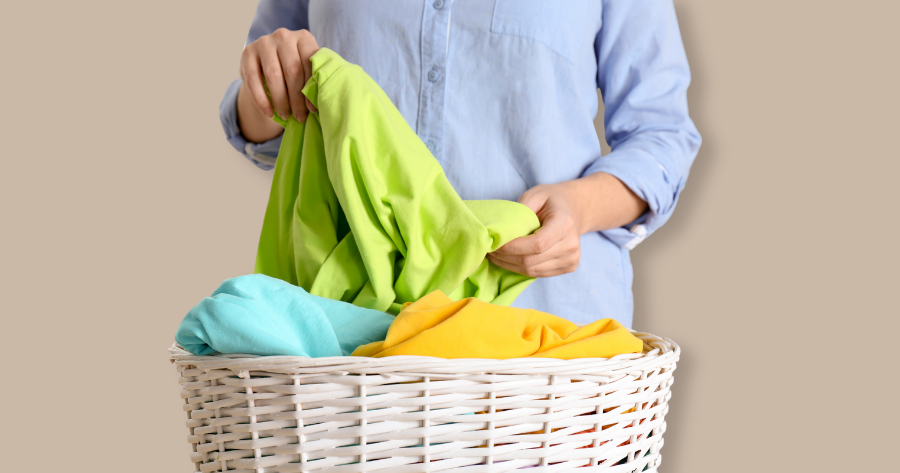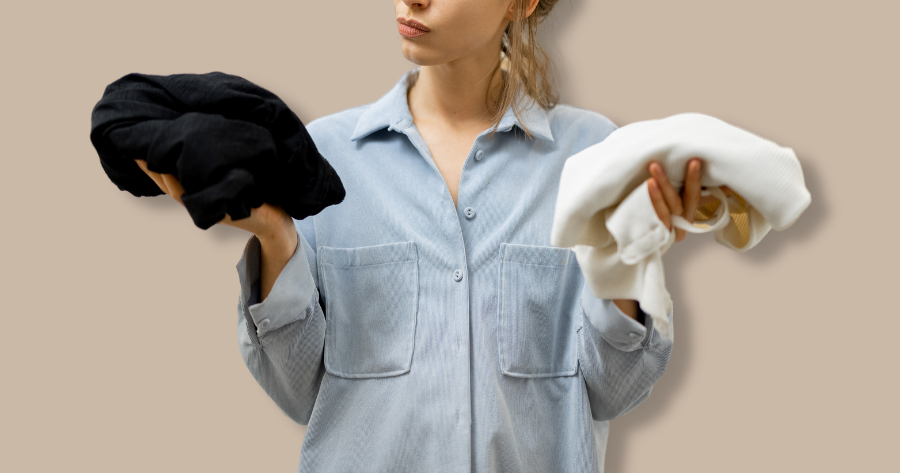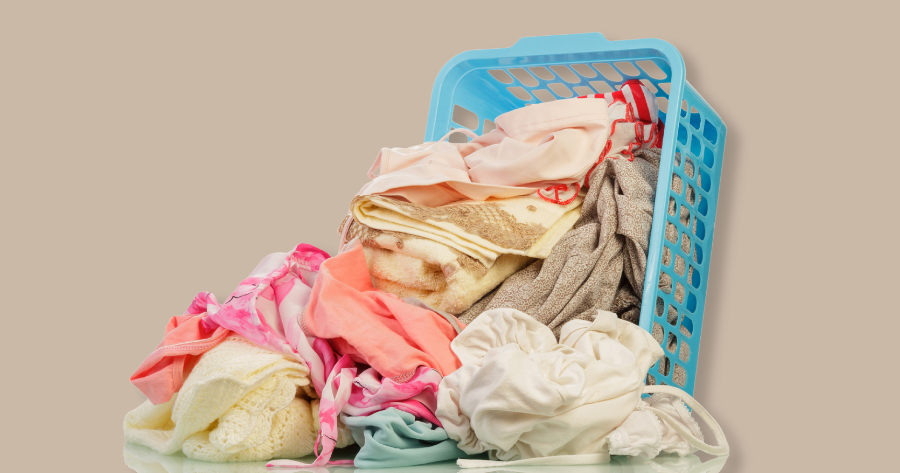
It’s easy to throw your weeklong load of laundry straight into the washing machine after a tiring day. Just a quick press on the start button, and you can say goodbye to your dirty laundry. But, it’s not a great idea to mix everything in one wash cycle.
There are a couple of factors to consider when you are sorting laundry. Among these factors are: 1) sorting clothes by color, 2) considering the fabric type, and 3) checking out how soiled the items are. In today’s post, you will learn how to separate the laundry efficiently. By following these tips, you can keep your clothes in top shape for longer.
Why Should You Sort Your Laundry
Mixing whites with colored clothes spells laundry disaster. For example, it’s easy to turn your white shirt to pink when you accidentally mix them with red socks. Separating laundry decreases your chance of color bleeding and fading.
Different clothes use different fabrics. Each fabric type needs specific attention according to its care label. When you sort laundry, you can choose the appropriate wash cycle and temperature that best suits each article of clothing. For starters, when you mix delicate clothes with tough fabrics such as jeans, there’s a high chance that you ruin the softer fabric type.
Think of clothes as an investment. When you separate laundry and categorize them, they can serve you better for longer.
How To Sort Clothes For Laundry
Separate Clothes by Color

A red sock is a notorious clothing article that can turn your whites to pink in one wash. Red socks color bleed easily. However, color bleeding is easy to avoid when you separate laundry.
Color bleeding happens when the dye from a colored fabric transfers to a lighter colored one when wet. The chances of color bleeding increase with the use of detergent or bleach during the wash cycle. If you ever had trouble with color bleeding, allow us to help you out by checking this post.
If you don’t want any color bleeding or transfer, it’s best to have three piles of laundry for your clothes and categorize them by color. You can sort them as whites, lights, and darks.
- Whites: The white laundry pile can include your underwear, delicates, socks, t-shirts, and dress shirts.
- Lights: You can sort your pastels such as pinks, lavender, light blue, and the like in the light-colored laundry pile.
- Darks: Your darks can include your black, gray, red, or navy clothing. You may also add your pieces of denim to this pile if you choose to wash them together.
Choose the Best Temperature per Color
Sorting laundry by color allows you to choose the best temperature for your clothes. Each fabric type requires specific temperatures to achieve optimal laundry results. Below is a quick guide on what water temperature setting works well for your clothes by color. Note that it’s still best to check each clothes’ care label before washing to keep them in top shape.
- Whites: You can use hot water for white clothes. The hot water can help lift off dirt and discoloration that is evident on white fabrics. It’s also safe to add bleach to your whites.
- Lights: You can wash your lightly-colored clothes with warm water.
- Brights and Darks: These colors are prone to color bleeding, especially if they are new. It’s safer to use cold water in washing bright or dark clothes to avoid removing the dye from the fabric during the wash cycle.
Separate Laundry by Fabric Type

It’s best to avoid washing together tough fabrics such as denim with delicate or light pieces. Your clothes get rubbed and tossed together during the wash cycle. Separating clothes by fabric type before washing them in the washing machine is necessary. Doing so avoids wear and tears on softer and more delicate garments. Moreover, sorting and washing light and heavy fabrics separately save you from the trouble of over-drying or under-drying during the drying cycle. Here are some tips on how to wash heavy fabric types.
- Washing your dark shirts with jeans in one load could work. But for best results, you can create a separate pile for clothes with sturdier fabrics such as denim.
- You should avoid washing items that produce lint such as towels with corduroy pieces in one laundry load.
Separate Laundry by the Amount of Dirt

If you live with kids or work in an industry where dirt is part of everyday living, stained and extra-soiled clothes may be a common sight in your laundry. It’s a good idea to add a hamper in your laundry room specifically labeled for extra-soiled or stained clothes. That way, you don’t have to dig into the pile of laundry to look for clothes with stains and dirt. Moreover, you can quickly take action in removing the stains while they are still new.
Stained or extra-soiled items need careful and immediate attention. They require pretreating or soaking to get rid of dirt and grime before washing. Moreover, doing so prevents the stain from transferring to other fabrics during the wash cycle.
A Few Tips When Separating Clothes for Laundry

Carefully sorting your laundry before washing may seem like a daunting task. However, streamlining the way you sort your laundry will reap benefits in the long run. Here are more tips on how you can further improve your laundry prep skills.
Always Check Pockets
Checking my clothes’ pockets is something that I always practice before I take off my clothes. I used to not pay much attention to checking my pockets before. However, I learned the hard way how tissue paper left inside a jacket’s pocket can cause a mess after washing.
As you separate the laundry, always check each clothing’s pocket for pieces of paper or coins and bills that may be left inside. It’s a good idea to involve your household members by asking them to always check their clothes’ pockets before tossing their clothes in the hamper.
Check for Loose Buttons or Threads
Buttons are necessary clothing accessories. They are functional as they are decorative. Hence missing one button in your dress shirt can be troublesome. When you wash clothes with a loose button, the buttons can get lost during the wash. During the wash cycle, clothes are agitated and rubbed in the washing machine. Hence it’s better to check for any loose buttons before you do your laundry.
Another thing to keep an eye on as you separate laundry is loose threads. Clothes with loose-knit, open-knit, or lightweight fabrics are prone to snags. Moreover, fabric snags can cause loose threads. Before you throw knitted articles in the washing machine, check first for any loose threads. Deal with them accordingly to avoid ruining the fabric. You can also use mesh laundry bags to protect clothes that snag easily.
Use Gentle Cycle for Delicates
You can wash delicate items like lacy undergarments, cotton dress shirts, and silk nightgowns in the washing machine. However, you need to wash them carefully. Remember to use the most gentle cycle your washer has. Delicate items are also best washed with cold water and mild detergent to avoid ruining the fabric. You can use laundry mesh bags with zippers to clean small articles such as undergarments. Doing so avoids friction and snags during the wash. It’s also a good idea to skip the dryer for delicates and line dry them instead.
Wash Multicolored Clothes with Similar Fabric Type
We already stressed the importance of laundry sorting by color, fabric type, and how dirty they are. However, washing multicolored clothes can be confusing. If you don’t know which colored pile to pick for your multicolored garments, you can choose to sort them according to their fabric type.
Wash New Dark Clothes Separately at First
Sometimes you can’t be sure if certain fabrics are colorfast. If you have new clothes with dark or bright colors, it’s better to wash them separately using cold water. You can do this process a couple of times to lock in the colors in the fabric. After a few washes, you can wash them with other clothes of similar colors.
Wash Denim Separately
Like dark or bright-colored clothes, denim is also prone to color bleeding and fading. If you just got a new pair of denim, you might observe your hands turning blue when you put them inside the pocket. Thus, it’s best to wash your newly brought pair of jeans in a separate laundry load during the first few washes. Turn them inside out before you wash them in cold water. Doing so will protect your jeans from fading.
Wash Towel and Sheets Separately
There are various reasons why it’s a good idea to wash your towels and sheets in a separate laundry. Here are a few of them.
- Towels and sheets get dirty before washing. Unlike clothes, you don’t get to wash your towels and sheets as often, but you use them every day. Thus, sweat and dead skin cells get trapped in the fabric for longer. With this in mind, you should always use hot water to wash and sanitize your towels and sheets. It’s also advisable to use the setting intended for heavier fabrics.
- Towels and sheets use heavier and bigger fabrics. Hence, they require a longer wash to get cleaned.
- Cotton towels are lint producers. Lints are tiny fibers from fabrics that shed after washing. They have a habit of clinging to other fabric types. Clothes can look unclean even if they are newly washed when lint clings onto them. Fabrics such as corduroys attract lint the most. Hence, it’s best to wash towels and corduroys separately.
- It’s hard to clean your clothes thoroughly when you wash them with towels and sheets. The clothes may get trapped on the sheet’s fabric. Hence clothes don’t get enough cleaning.
Have a Laundry Sorting Strategy
Sorting the laundry is easy if you are living alone. You only have your clothes alone so it should be easier for you as you are more familiar with your belongings. However, sorting laundry can be quite a challenge if you do the household’s laundry a couple of times a week. With that, you should carefully strategize how you sort laundry at home to save you time and effort before washing.
It doesn’t matter whether you are living alone or doing the family laundry. It’s still best to invest in a laundry sorter. There are a lot of options to choose from in your local home store. By investing in a laundry sorter, you can immediately sort your laundry even before wash day. You can assign separate compartments for whites, darks, or lights. Some hampers even have more partitions. Just choose the one that best suits your needs.
In Conclusion
Sorting the laundry may sound basic, but it is one of the foundations in achieving great laundry results. The most basic sorting technique is to sort your laundry by color. However, there are more factors to consider if you want to improve how you sort and wash your laundry.
By streamlining your laundry sorting strategies, you will likely avoid laundry mishaps such as color bleeding or lint accumulation. The best part? You can get more wear from your clothes by taking the time and effort to care for them.
Want to share this?

